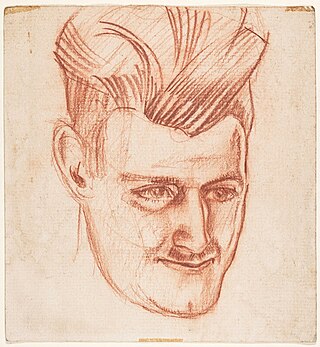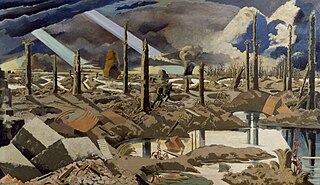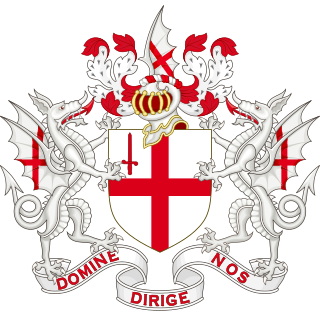
Christopher Richard Wynne Nevinson was an English figure and landscape painter, etcher and lithographer, who was one of the most famous war artists of World War I. He is often referred to by his initials C. R. W. Nevinson, and was also known as Richard.

Paul Nash was a British surrealist painter and war artist, as well as a photographer, writer and designer of applied art. Nash was among the most important landscape artists of the first half of the twentieth century. He played a key role in the development of Modernism in English art.

Lance Corporal Henry James Tandey VC, DCM, MM was a British recipient of the Victoria Cross, the highest award for gallantry in the face of the enemy that can be awarded to British and Commonwealth forces. He was the second most highly decorated British private of the First World War and is most commonly remembered as the soldier who allegedly spared Adolf Hitler's life during the first world war. Born with the family name of Tandy, he later changed his surname to Tandey after problems with his father, and because of this, some military records have a different spelling of his name.

Major Sir William Newenham Montague Orpen, was an Irish artist who mainly worked in London. Orpen was a fine draughtsman and a popular, commercially successful painter of portraits for the well-to-do in Edwardian society, though many of his most striking paintings are self-portraits.

The Attacks on the Butte de Warlencourt describe a tactical incident during the Battle of the Somme. The Butte de Warlencourt is an ancient burial mound off the Albert–Bapaume road, north-east of Le Sars in the Somme département in northern France. It is located on the territory of the commune of Warlencourt-Eaucourt and slightly north of a minor road to Gueudecourt and Eaucourt l'Abbaye. During the First World War, German troops constructed deep dugouts in the Butte and surrounded it by several belts of barbed wire, making it a formidable defensive position in advance of Gallwitz Riegel. After the Battle of Flers–Courcelette, the view from the Butte dominated the new British front line and was used by the Germans for artillery observation.
John Northcote Nash was a British painter of landscapes and still-lifes, and a wood engraver and illustrator, particularly of botanic works. He was the younger brother of the artist Paul Nash.
Over the top may refer to:

The Indian Army, also called the British Indian Army, was involved in World War I as part of the British Empire. More than one million Indian troops served overseas, of whom more than 60,000 died during the war.
The 39th Garhwal Rifles was an infantry regiment of the British Indian Army.

Eric Henri Kennington was an English sculptor, artist and illustrator, and an official war artist in both of the world wars.

The First World War, which was fought between 1914 and 1918, had an immediate impact on popular culture. In the over a hundred years since the war ended, the war has resulted in many artistic and cultural works from all sides and nations that participated in the war. This included artworks, books, poems, films, television, music, and more recently, video games. Many of these pieces were created by soldiers who took part in the war.
British official war artists were a select group of artists who were employed on contract, or commissioned to produce specific works during the First World War, the Second World War and select military actions in the post-war period. Official war artists have been appointed by governments for information or propaganda purposes and to record events on the battlefield; but there are many other types of war artist.

The 59th Division was an infantry division of the British Army during World War I. It was formed in late 1914/early 1915 as a 2nd Line Territorial Force formation raised as a duplicate of the 46th Division. After training in the United Kingdom and seeing service in the Easter Rising in April 1916, the division joined the British Expeditionary Force (BEF) on the Western Front in early 1917. It saw action at Ypres and Cambrai, and was almost destroyed during the German Army's Spring Offensive in March 1918. The reconstituted division took part in the final advances of the war.

Sydney William Carline was a British artist and teacher known for his depictions of aerial combat painted during World War One.

We Are Making a New World is a 1918 oil-on-canvas painting by Paul Nash. The optimistic title contrasts with Nash's depiction of a scarred landscape created by a battle of the First World War, with shell-holes, mounds of earth, and leafless tree trunks. Nash's first major painting and his most famous work, it has been described as one of the best British paintings of the 20th century, and compared to Picasso's Guernica. "Yet it is worth remembering that the picture was a piece of official art and that it first appeared, untitled, as the cover of an issue of British War Artists at the Front, published by Country Life. ... [It] was promulgated in 1917 as covert propaganda for the Allied cause."

The Menin Road is a large oil painting by Paul Nash completed in 1919 that depicts a First World War battlefield. Nash was commissioned by the British War Memorials Committee to paint a battlefield scene for the proposed national Hall of Remembrance. The painting is considered one of the most iconic images of the First World War and is held by the Imperial War Museum.

The Kensingtons at Laventie is a large oil painting on glass by Eric Kennington completed in 1915 that depicts a First World War platoon of British troops. The group depicted was Kennington's own infantry platoon; Platoon No 7, C Company, the 1/13th Battalion, the London Regiment (Kensington), who were commonly known as the Kensingtons. Kennington completed the painting having been invalided out of the British Army due to wounds suffered on the Western Front in early 1915.

Sunrise, Inverness Copse is a 1918 watercolour by English artist Paul Nash, which was produced during World War I. It depicts a scene from the Western Front near Ypres in Belgium, and was developed from an eye-witness sketch which Nash drew whilst at the scene in 1917. The drawing is in the collection of the Imperial War Museum, in London.

The Royal London Militia was an auxiliary regiment organised in the City of London during the French Revolutionary War from the former London Trained Bands. It later became part of the Royal Fusiliers. After conversion to the Special Reserve (SR) under the Haldane Reforms it was one of just a handful of SR units to see combat during World War I, fighting in many actions on the Western Front from 1916 until the Armistice in 1918. After a shadowy postwar existence the unit was finally disbanded in 1953.

The Ypres Salient at Night is a 1918 watercolour by English artist Paul Nash, which was produced during World War I. It depicts a scene from the Western Front near Ypres in Belgium, and was developed from an eye-witness sketch which Nash drew whilst at the scene in 1917. The drawing is in the collection of the Imperial War Museum, in London.


















